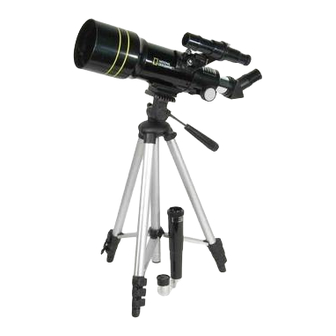
Summary of Contents for National Geographic NG70FS
- Page 1 NG70FS Telescope Instructions Owner’s Manual Manual Part #: 284445-051909E Printed in China Please retain this manual for future reference.
- Page 2 A: Lens hood / shade B: Metal optical tube C: 5 X 24 Finderscope D: Finderscope bracket E: 20-mm eyepiece F: 45º prism G: Focus knob H: Tilt handle I: Tripod leg J: 3X Barlow lens K: 4-mm eyepiece L: Tripod leg locks M: Horizontal adjustment lock N: Tripod attachment plate O: Centre column adjustment Lock...
- Page 3 As a terrestrial (land) telescope, the NG70FS delivers great views of mountains, valleys, and many other features of the world around us. You can also use the NG70FS to study animals and landscapes at a distance. To obtain the best performance from your telescope, please read this manual carefully and completely.
- Page 4 column adjustment lock knob. Raise or lower the centre column. Re-tighten the centre column adjustment lock knob. (See Fig. 1) (Fig. 2) 9) Loosen the small knob or screw on the side of the focus tube by turning it anti-clockwise. Remove the white plastic dust cover from the focus tube.
- Page 5 LTAZIMUTH OUNT The NG70FS telescope is fitted with an altazimuth mount. “Alt” refers to altitude, the vertical movement of the telescope, while “azimuth” refers to the horizontal movement. To change the angle of the telescope’s optical tube, simply loosen the handle of the tilt arm. Adjust the position of the optical tube and re-tighten the handle of the tilt arm.
- Page 6 The level of magnification required depends on the object being observed. Optimal performance is obtained if the magnification is typically not more than approximately 30X for every 10-mm of objective lens diameter. Magnification of around 210X less is ideal for a telescope with a 70-mm diameter objective lens and is best for observing most celestial objects.
- Page 7 LANETS The planets, our solar system companions, range in size and substance from moon-size rocky bodies to giant gas balls, which could hold Earth 1,000 times over. To find the planets, you will need information about their times of visibility. An astronomy magazine will give you the locations of the planets as they change position from month to month.
- Page 8 Experience the National Geographic Channel. conservation, research, and education programs. Call your cable or satellite provider for availability. Visit our website: www.nationalgeographic.com © 2009 National Geographic Society. NATIONAL GEOGRAPHIC and Yellow Border are trademarks of National Geographic Society. All rights reserved...











